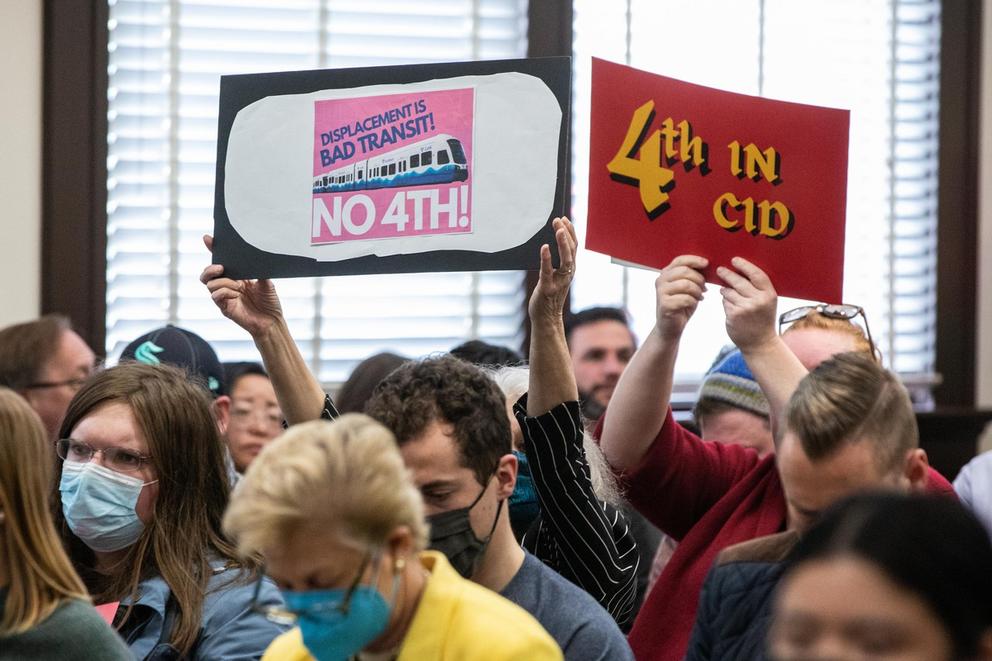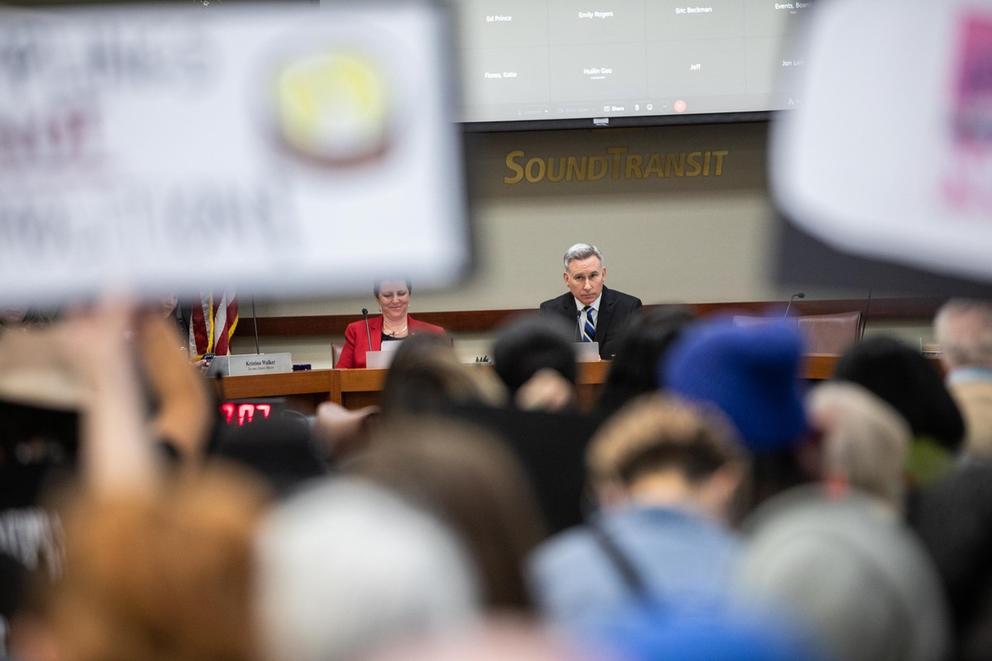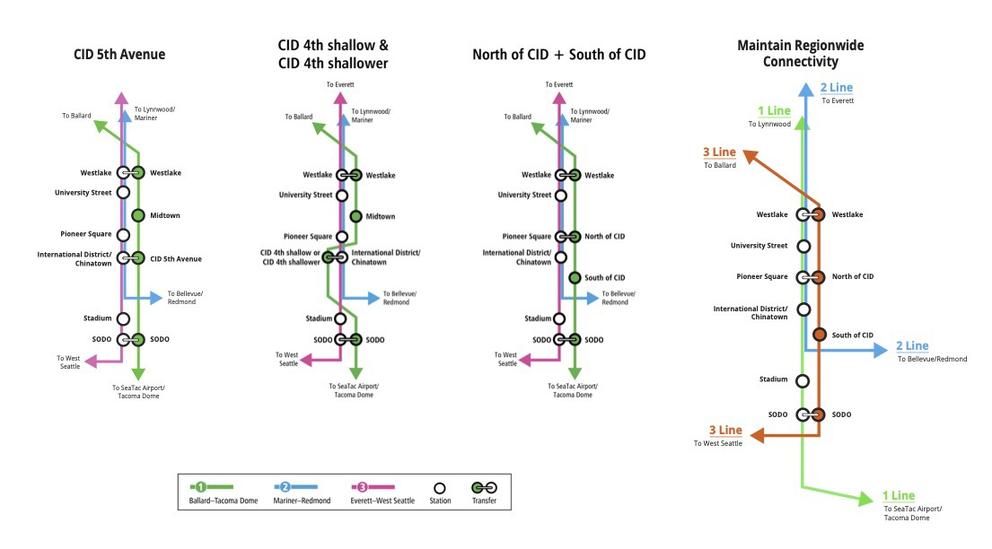With a 15-to-1 vote, the Board adopted an 11th-hour proposal from Seattle Mayor Bruce Harrell and King County Executive Dow Constantine to build stations just north and south of the Chinatown-International District (CID), rather than on Fourth Avenue adjacent to the existing CID light rail station.
The vote is far from a final decision on station location — Sound Transit staff need to conduct a lengthy analysis of each proposed site before the Board votes on the final location(s). But the vote signals the Board’s preference for a plan that would create two new stations currently called “North of CID” and “South of CID.”
The new stations are part of the third phase of LINK light rail. Approved by voters in 2016, the more than $54 billion system expansion will build light rail from Tacoma to Everett and add a second tunnel through downtown Seattle as part of a new line that will run from Ballard to West Seattle.
The North of CID station would be built underneath the existing King County Administration Building at Fourth Avenue and James Street. Constantine wants the station there as part of the Civic Campus redevelopment effort he announced in his State of the County address in early March, which would bring new housing and businesses to the area.
The South of CID station would be built at Sixth Avenue and Seattle Boulevard, a few blocks south of the Uwajimaya grocery store, which sits near the southwest corner of the CID, and a few blocks north of the existing Stadium Station that serves T-Mobile Park and Lumen Field.
In the original expansion proposal, the Sound Transit Board was tasked with choosing between building a station on either Fifth or Fourth Avenues in the CID. The Fifth Avenue station was a nonstarter for neighborhood elders, business owners and advocates who feared that construction through the heart of the neighborhood would be devastating.
That group, which called itself Transit Equity for All and grew to include transit advocates and Pioneer Square business groups, threw its support behind the Fourth Avenue station, saying it would be a benefit for the neighborhood and the optimal choice for easy and fast connections between transit lines.
The Board sided with that coalition initially, agreeing that the Fifth Avenue station was off the table and delaying its vote to provide more time to study a Fourth Avenue station option. But in the end they coalesced around Harrell’s last-minute proposal to build the North/South of CID stations.
Several Board members, including Pierce County Executive Bruce Dammeier and Snohomish County Executive Dave Somers, said they wanted to defer to Harrell’s local expertise and authority when making decisions about Seattle stations.
The Board’s support for building outside the CID was a victory for a separate coalition of neighborhood activists, progressive political groups such as Puget Sound Sage, community nonprofits like InterIm CDA, and mutual aid groups who’d been organizing against building anything new in the neighborhood.
They feared the estimated decade of construction for a Fourth Avenue station would harm the neighborhood in the immediate term, and that the gentrification that might come with improved transit would continue to displace low-income Asian American residents and community businesses.
“Transit systems, no matter how ideally conceived, cannot be lines drawn on a map without consideration of the people beneath those lines,” said Christina Shimizu, Puget Sound Sage executive director, at Thursday’s meeting. “A truly equitable and inclusive urbanism, transit, and density done right means policymakers must listen to communities of color and trust that we know what’s best for our neighborhoods.”
Though the Board voiced support for the North and South stations, the Fourth Avenue option isn’t completely off the table. Thanks to an amendment from Board member and King County Councilmember Claudia Balducci, the Sound Transit staff will continue to study the Fourth Avenue station option as part of its final analysis, meaning the Board could choose it in the end.
“This is potentially the most important station that this agency will build on this light rail line … in what is potentially the most unique, critical, precious neighborhood and all that entails,” said Balducci.
She continued, “I think there is more to be learned. If we do eventually have to say [Fourth Avenue] can’t happen, we will be able to look the public in the face and say we did the best we could. I don’t know if I could do that today.”
Though Somers supported Harrell’s North/South station proposal, he was ultimately the lone "No" vote on the final amended package. He told Crosscut his dissent was a response to the amendments his colleagues added.
“Other last-minute proposals would almost certainly cause delays, and the costs are well beyond what has been budgeted with no ideas how to pay for them. The Board should not sacrifice our timeline and budget when we have very good alternatives in front of us,” said Somers.
Transit advocates and other supporters say the Fourth Avenue Station would provide the best transit service. Because the station would sit between the existing CID light rail station on Fifth Avenue and the King Street Station, which currently serves Amtrak and Sound Transit’s Sounder commuter train, it would provide direct transfer between light rail lines and from the other rail systems to light rail. With the North/South station options, transfers between light rail lines will require walks of 10 minutes or more in some cases. People transferring from Amtrak or Sounder lines to light rail would have to exit to street level rather than connect underground.
Amy Chen Lozano, a leader in the coalition advocating for the Fourth Avenue station, said supporters in the CID think a Fourth Avenue station would benefit the neighborhood in the long run by bringing more visitors to patronize shops and restaurants and provide more foot traffic to help tamp down on public safety issues the neighborhood faces.
The Fourth Avenue station is, however, estimated to cost $700 million to $800 million more than the Board’s baseline estimate (which is based on the Fifth Avenue station idea). That’s a nonstarter for some Board members.
“To me anything we do that says we might actually consider something that adds $800 million over the baseline is ridiculous,” said Dammeier. “Nobody has that amount of money. And frankly if we had $800 million, I think we’d spend it different.”
Early analysis from Sound Transit staff estimates the North/South of CID option would cost $160 million more than baseline.
The shift to a North/South station alignment would have consequences for the First Hill neighborhood as well. The North station would preclude construction of a Midtown station at Fourth and Madison, which would be connected to First Hill by the new RapidRide G Line bus. First Hill was slated to get a station as part of the original light rail line, but the Board ultimately decided it would be too expensive to build.
“It's a real loss for our community,” said Alex Hudson, Transportation Choices Coalition executive director and District 3 city council candidate. “The Midtown station is projected to be the third-highest ridership station in all of Sound Transit Three. … We need to figure out a real solution that keeps those folks having the easiest, most efficient experience getting to and from where they need to go.”
Sound Transit will soon begin the lengthy analysis required to complete a final Environmental Impact Statement. Once that is complete, the Board will make its final decisions on where Seattle’s future light rail stations will be built.






